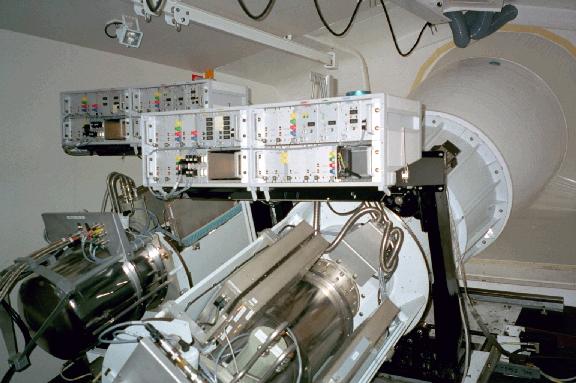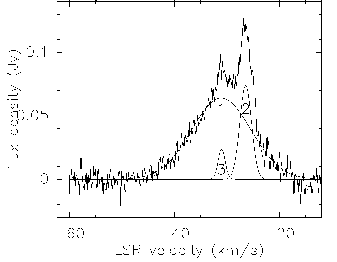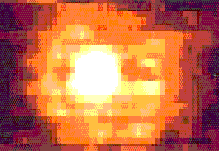Asymptotic Giant Branch (AGB) stars are in a decisive stage of the stellar evolution : they are extremely luminous (several thousand times the luminosity of the Sun) and undergo mass loss at large rate (several million to several billion times the rate of the Solar Wind). These stars cannot survive for a long time in such a stage, possibly around one million years, which is short as compared to their lifetime, from 1 to 10 Gigayears. After this spectacular stage they stop expelling matter and producing energy, and then cool down slowly as white dwarfs ; for a short time they are still luminous enough to illuminate the circumstellar material that they lately expelled, giving marvels known as Planetary Nebulae :

It is through this phenomenon of mass loss that the low and intermediate mass stars (i.e. those which at birth had a mass around the one of the Sun or a few times) avoid ending their lifes as Supernovae. On the other hand, the rare stars with initial mass larger than 6 to 8 solar masses follow a different evolution which may lead to such catastrophic fate. It is also through mass loss that stars are replenishing the Interstellar Medium with material which has been enriched in elements nuclearly processed in their interiors. They are thus participating to the chemical evolution of the Universe. Understanding the dynamics of circumstellar outflows and the history of mass loss from AGB stars is thus one of the challenges of the research in stellar physics. As it expands, the material in the circumstellar shells is slowly cooling down. Dust is condensing in the form of small carbon or silicate particles, and molecules, such as CO or OH, are formed. Mass loss from evolved stars has therefore been probed essentially through dust emission (infrared continuum) or molecular line emissions (in the radio range). However this approach is suffering from several limitations because the dust or molecules which are observed constitute only a minor component (< 1 %) of the material ejected from red giants. In addition, the proportion of this component is not well known. In these conditions it has been difficult to establish a balance of the mass lost as a function of time, a datum which is seriously needed to describe the post-main sequence evolution of low and intermediate-mass stars (M < 6-8 solar masses). Hydrogen is the most abundant element in the Universe and also in the wind from late-type giants. Therefore the emission from atomic hydrogen in the ground state should be one of the best tracer of the mass loss history. Also, as hydrogen is the most common element in stars, its measurement is almost equivalent to probing directly the total mass. Atomic hydrogen can be characterized through a well-known transition which is observed at the wavelength of 21 cm. This transition has been widely used to map the galactic interstellar medium and to discover the spiral structure of our Galaxy. It is found in the radio domain at a frequency of 1420 MHz, close to those used for terrestrial, airborne and spaceborne transmissions. Fortunately the range from 1400 to 1427 MHz is protected for scientific applications ! However past attempts to detect this line from circumstellar shells have failed, basically because : 1. the emission from HI at 21 cm is weak, 2. the interstellar medium on the line of sight often produces an HI emission which makes an intense background against which the weak circumstellar signal has to be discriminated, 3. the hydrogen in the outflows might possibly be molecular rather than atomic. The searches carried out in the eighties had then been given up. Eric Gérard and Thibaut Le Bertre from the Observatory of Paris have undertaken a new search for the HI line at 21 cm with the renovated Nançay Radio Telescope (NRT). Indeed this telescope originally built in the sixties has recently been refurbished by the Institut National des Sciences de l’Univers (INSU) and the Observatory of Paris with the collaboration of australian engineers of the CSIRO and with the financial support of the Conseil Régional de la Région Centre in France.

Thanks to the improved sensitivity of the instrument and to a careful observing strategy they could discover HI emission from several stellar sources. One of their first detections was from the star RS Cnc. From the very particular spectral profile of the emission they could deduce that atomic hydrogen is present already in the central star’s atmosphere. This result showed that hydrogen could already be in atomic form close to the central star, and that it could be much more common than previously thought. They now have discovered it in several other sources. In one of them, the Semi-Regular Variable EP Aqr, the emission is spectacular. It can be decomposed into 3 components which trace different dynamical structures of the circumstellar shell. The 2 main components (1 and 2 in figure 3) are very extended and can be angularly resolved with the NRT. The distance to the star has been measured by the European satellite Hipparcosand is about 135 parsec, or 440 light years. At this distance, the size of the circumstellar shell detected in HI is about 1.6 parsec or 5 light years !

The size of the EP Aqr circumstellar shell is so large that it is comparable to the average separation of stars in the Solar Neighborhood. Its apparent extension is about one degree over the sky (i.e. twice as much as the Sun or the Moon, although it is of course much farther !). The circumstellar shells detected in HI by Gérard & Le Bertre are roughly centered on the stars, but sometimes exhibit a distribution of matter which is complex, with large-scale density-enhancements, like those that can be seen in planetary nebulae. In fact, the HI line allows to probe circumstellar material so far from the central star that in another case (the carbon star Y CVn), Gérard and Le Bertre could from their HI data detect the interaction between the stellar outflow and the Interstellar Medium.

The advent of radio-interferometer with large field of view, such as the EVLA or the SKA, will allow to map with excellent angular resolution and sensitivity the HI shell surrounding Y CVn and other AGB stars. It has the potential to resolve the dynamic structure of AGB outflows. It will bring results on the history of mass loss which cannot be obtained by other means, and also informations on the way stellar matter, enriched in elements produced in their interiors, is re-injected into the ISM (an essential step of the cosmic cycle of matter). This prospect nicely complements ALMA which will soon allow to detect the emission of molecular species like CO, and thus will give access to the structure of circumstellar shells close to the central stars.
The results obtained by Gérard and Le Bertre demonstrate that the circumstellar-HI line-profiles contain an unexpected wealth of informations on the history of mass loss from red giants, on the spatial and kinematic structure of circumstellar shells and on the interaction between stellar winds and the interstellar medium.
The large radio-interferometers which are presently in phases of conception or construction will provide essential contributions to our knowledge of the evolution of these important celestial sources.
Le Bertre T., Gérard E., 2004, "The circumstellar environments of EP Aqr and Y CVn probed through the HI emission at 21 cm", Astronomy & Astrophysics, in press Gérard E., Le Bertre T., 2003, "The HI emission profile of RS Cnc", Astronomy & Astrophysics 397, L17
